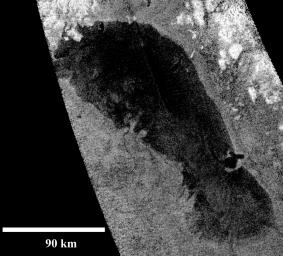This image of Ontario Lacus, the largest lake on the southern hemisphere of Saturn's moon Titan, was obtained by NASA's Cassini spacecraft on Jan. 12, 2010.
North is up in this image. Objects appear bright in this radar image when they are tilted toward the spacecraft or have rough surfaces. The lake surface appears dark because it is smooth.
The northern shoreline features flooded river valleys and hills as high as 1 kilometer (3,000 feet) in altitude.
A smooth, wave-sculpted shoreline, like that seen on the southeastern side of Lake Michigan, can be seen at the northeastern part of the lake. Smooth lines parallel to the current shoreline could be formed by low waves over time, which were likely driven by winds sweeping in from the west or southwest.
The southeast shore features a round-headed bay intruding into the shore. The liquid-filled depressions appear to be relatively recent.
The middle part of the western shoreline shows the first well-developed delta observed on Titan. The shape of the delta shows that liquid flowing down from a higher plain has switched channels on its way into the lake, forming at least two lobes. Examples of this kind of channel switching and wave-modified deltas can be found on Earth at the southern end of Lake Albert between Uganda and the Democratic Republic of Congo in Africa and the remains of an ancient lake known as Megachad in the African country Chad.
Titan is the only other world in our solar system known to have standing bodies of liquid on its surface. Because surface temperatures at the poles average a chilly 90 Kelvin (about minus 300 degrees Fahrenheit), the liquid is a combination of methane, ethane, and propane, rather than water. Ontario Lacus has a surface area of about 15,000 square kilometers (6,000 square miles), slightly smaller than its terrestrial namesake, Lake Ontario.
For an earlier image of Ontario Lacus obtained by Cassini's imaging cameras, see PIA06240.
The Cassini-Huygens mission is a cooperative project of NASA, the European Space Agency and the Italian Space Agency. NASA's Jet Propulsion Laboratory, a division of the California Institute of Technology in Pasadena, manages the mission for NASA's Science Mission Directorate, Washington, D.C. The Cassini orbiter was designed, developed and assembled at JPL. The radar instrument was built by JPL and the Italian Space Agency, working with team members from the United States and several European countries.

 Planetary Data System
Planetary Data System












